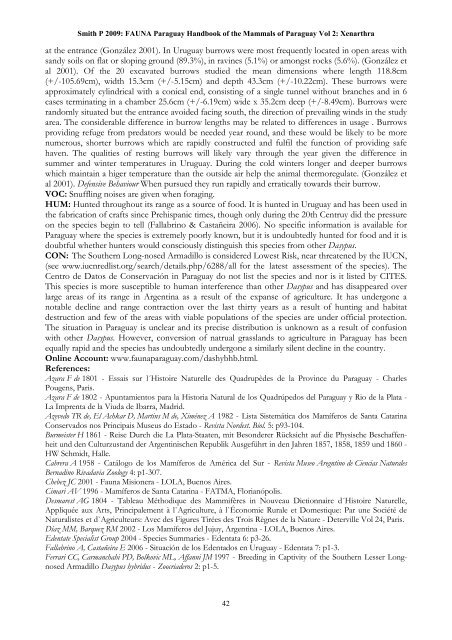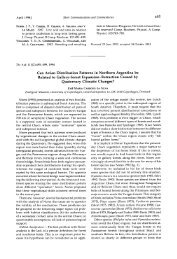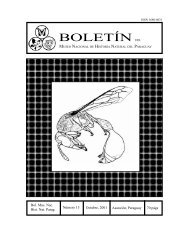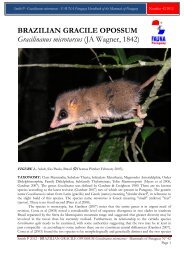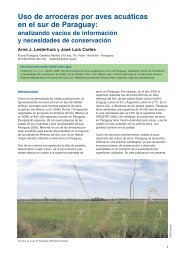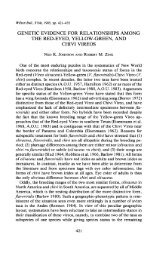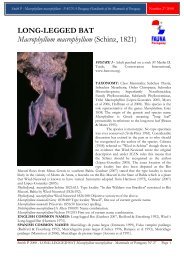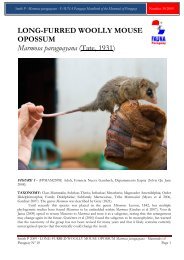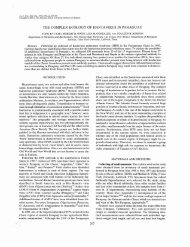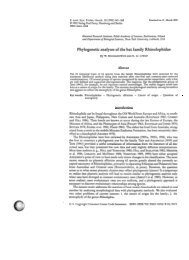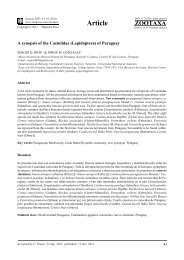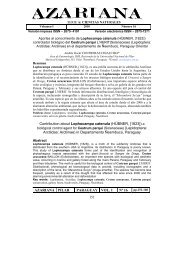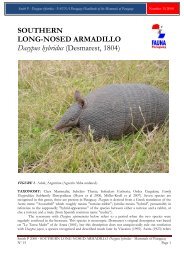hbk mammals vol 2 - FAUNA Paraguay
hbk mammals vol 2 - FAUNA Paraguay
hbk mammals vol 2 - FAUNA Paraguay
You also want an ePaper? Increase the reach of your titles
YUMPU automatically turns print PDFs into web optimized ePapers that Google loves.
Smith P 2009: <strong>FAUNA</strong> <strong>Paraguay</strong> Handbook of the Mammals of <strong>Paraguay</strong> Vol 2: Xenarthra<br />
at the entrance (González 2001). In Uruguay burrows were most frequently located in open areas with<br />
sandy soils on flat or sloping ground (89.3%), in ravines (5.1%) or amongst rocks (5.6%). (González et<br />
al 2001). Of the 20 excavated burrows studied the mean dimensions where length 118.8cm<br />
(+/-105.69cm), width 15.3cm (+/-5.15cm) and depth 43.3cm (+/-10.22cm). These burrows were<br />
approximately cylindrical with a conical end, consisting of a single tunnel without branches and in 6<br />
cases terminating in a chamber 25.6cm (+/-6.19cm) wide x 35.2cm deep (+/-8.49cm). Burrows were<br />
randomly situated but the entrance avoided facing south, the direction of prevailing winds in the study<br />
area. The considerable difference in burrow lengths may be related to differences in usage . Burrows<br />
providing refuge from predators would be needed year round, and these would be likely to be more<br />
numerous, shorter burrows which are rapidly constructed and fulfil the function of providing safe<br />
haven. The qualities of resting burrows will likely vary through the year given the difference in<br />
summer and winter temperatures in Uruguay. During the cold winters longer and deeper burrows<br />
which maintain a higer temperature than the outside air help the animal thermoregulate. (González et<br />
al 2001). Defensive Behaviour When pursued they run rapidly and erratically towards their burrow.<br />
VOC: Snuffling noises are given when foraging.<br />
HUM: Hunted throughout its range as a source of food. It is hunted in Uruguay and has been used in<br />
the fabrication of crafts since Prehispanic times, though only during the 20th Centruy did the pressure<br />
on the species begin to tell (Fallabrino & Castañeira 2006). No specific information is available for<br />
<strong>Paraguay</strong> where the species is extremely poorly known, but it is undoubtedly hunted for food and it is<br />
doubtful whether hunters would consciously distinguish this species from other Dasypus.<br />
CON: The Southern Long-nosed Armadillo is considered Lowest Risk, near threatened by the IUCN,<br />
(see www.iucnredlist.org/search/details.php/6288/all for the latest assessment of the species). The<br />
Centro de Datos de Conservación in <strong>Paraguay</strong> do not list the species and nor is it listed by CITES.<br />
This species is more susceptible to human interference than other Dasypus and has disappeared over<br />
large areas of its range in Argentina as a result of the expanse of agriculture. It has undergone a<br />
notable decline and range contraction over the last thirty years as a result of hunting and habitat<br />
destruction and few of the areas with viable populations of the species are under official protection.<br />
The situation in <strong>Paraguay</strong> is unclear and its precise distribution is unknown as a result of confusion<br />
with other Dasypus. However, conversion of natrual grasslands to agriculture in <strong>Paraguay</strong> has been<br />
equally rapid and the species has undoubtedly undergone a similarly silent decline in the country.<br />
Online Account: www.faunaparaguay.com/dashybhb.html.<br />
References:<br />
Azara F de 1801 - Essais sur l´Histoire Naturelle des Quadrupèdes de la Province du <strong>Paraguay</strong> - Charles<br />
Pougens, Paris.<br />
Azara F de 1802 - Apuntamientos para la Historia Natural de los Quadrúpedos del <strong>Paraguay</strong> y Rio de la Plata -<br />
La Imprenta de la Viuda de Ibarra, Madrid.<br />
Azevedo TR de, El Achkar D, Martins M de, Ximénez A 1982 - Lista Sistemática dos Mamíferos de Santa Catarina<br />
Conservados nos Principais Museus do Estado - Revista Nordest. Biol. 5: p93-104.<br />
Burmeister H 1861 - Reise Durch die La Plata-Staaten, mit Besonderer Rücksicht auf die Physische Beschaffenheit<br />
und den Culturzustand der Argentinischen Republik Ausgeführt in den Jahren 1857, 1858, 1859 und 1860 -<br />
HW Schmidt, Halle.<br />
Cabrera A 1958 - Catálogo de los Mamíferos de América del Sur - Revista Museo Aregntino de Ciencias Naturales<br />
Bernadino Rivadavia Zoology 4: p1-307.<br />
Chebez JC 2001 - Fauna Misionera - LOLA, Buenos Aires.<br />
Cimari AV 1996 - Mamíferos de Santa Catarina - FATMA, Florianópolis.<br />
Desmarest AG 1804 - Tableau Méthodique des Mammifères in Nouveau Dictionnaire d´Histoire Naturelle,<br />
Appliquée aux Arts, Principalement à l`Agriculture, à l`Économie Rurale et Domestique: Par une Société de<br />
Naturalistes et d`Agriculteurs: Avec des Figures Tirées des Trois Règnes de la Nature - Deterville Vol 24, Paris.<br />
Díaz MM, Barquez RM 2002 - Los Mamíferos del Jujuy, Argentina - LOLA, Buenos Aires.<br />
Edentate Specialist Group 2004 - Species Summaries - Edentata 6: p3-26.<br />
Fallabrino A, Castañeira E 2006 - Situación de los Edentados en Uruguay - Edentata 7: p1-3.<br />
Ferrari CC, Carmanchahi PD, Bolkovic ML, Affanni JM 1997 - Breeding in Captivity of the Southern Lesser Longnosed<br />
Armadillo Dasypus hybridus - Zoocriaderos 2: p1-5.<br />
42


